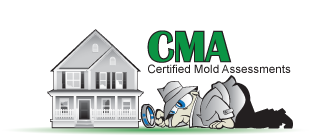 Mold spores can be found anywhere and often grow in areas with favorable conditions for their existence. They can be invisible to the naked eye during early stages but can multiply rapidly in the presence of moisture making them visible in large numbers. Mold can become hazardous if left unattended as it may cause respiratory problems and sinus infections. It is a common belief that mold can dry out and die after some time. Mold requires more than moisture to grow as it relies on other factors such as warmth, source of food, and oxygen. This article discusses whether mold can dry out and die and how to prevent it from coming back.
Mold spores can be found anywhere and often grow in areas with favorable conditions for their existence. They can be invisible to the naked eye during early stages but can multiply rapidly in the presence of moisture making them visible in large numbers. Mold can become hazardous if left unattended as it may cause respiratory problems and sinus infections. It is a common belief that mold can dry out and die after some time. Mold requires more than moisture to grow as it relies on other factors such as warmth, source of food, and oxygen. This article discusses whether mold can dry out and die and how to prevent it from coming back.
Contact Certified Mold Assessments for more info or for a mold service quote.
Moisture Problems That Cause Mold Growth
It is quite difficult to prevent mold growth without proper moisture control. Water intrusion or high levels of humidity can cause mold issues. Surface or groundwater may enter your home because of poor foundation drainage. Rainwater can get into a home through leaks in the roof, windows, or walls. It can also seep through the cement floor in buildings that have a slab construction, causing mold to grow on carpets, drywall, or furniture.
Mold can also grow on damp materials or rooms with poor ventilation since there is no free circulation of air. If the relative humidity indoors is maintained below 60 percent, and there are no cold-condensing surfaces, then there will be no enough moisture for mold to grow. However, cutting off any sources of moisture may dry out mold and prevent it from multiplying but they do not die easily.
What Happens to Mold When it Dries Out?
Mold spores become inactive temporarily after they have dried out but can remain a threat as long as they are present in the environment. It can cause allergic reactions and uncomfortable symptoms such as skin rashes, runny nose, itchy eyes, coughing, and sneezing. This usually occurs even if the mold spores are inactive because they can easily become airborne when blown around with the air circulating in and out of the house. Once they become airborne, they can move from one place to another and may end up settling in an area with all the necessary conditions for their growth. Mold requires moisture to grow but can remain inactive for a while until it is exposed to moisture or high levels of humidity.
Without constant moisture, mold will become inactive but they never die unless you get rid of them completely. They can always come back to life in the presence of moisture and multiply rapidly causing serious health problems. Some types of mold spores can remain in their passive state for several years under the right circumstances. It is not enough to eliminate moisture when you have an active mold problem in your home, as it will still find a way to multiply once again. The best way to get rid of recurring mold is to eliminate any contaminated materials and perform a remediation procedure to ensure they never grow back.
How to Prevent Mold From Coming Back
Mold in a home can be troublesome and unsettling as it causes health concerns to its occupants and may compromise the integrity of your structure. It is important to seek professional help if you find mold in your home as they have the right tools and experience to get rid of mold. After remediation, it is important to control the level of moisture and humidity in your home as they facilitate rapid mold growth. You can reduce the potential for mold growth by wiping up any puddles of water as soon as possible. You can also insulate surfaces that are prone to condensation as it helps to address the root cause of the problem. Mold is less likely to grow in a room with a low level of humidity. You can use your dehumidifier to maintain the level of humidity below 50 percent. It is also important to conduct frequent maintenance and repairs both inside and outside your home. Check for leaks in the ceiling, plumbing pipes, in your basement and near windows. You need to repair any leaks and clean your gutters regularly to prevent mold from growing.
Mold does not dry out and die but remains inactive for a while if moisture is not available. This means that it can still grow back and multiply when it is exposed to any sources of moisture. Professional mold remediation and moisture control help to keep mold at bay. It is also important to allow proper air circulation to get rid of excess moisture and stale air that can encourage mold growth.
